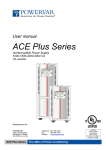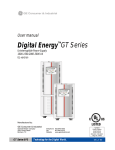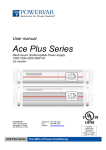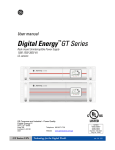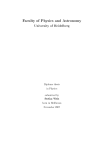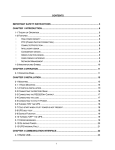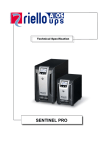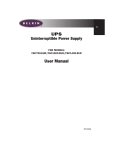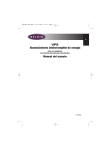Download FT1-SHUTTLE-SU LPS User Manual Rev 4
Transcript
Franek Technologies, Inc. 800.326.6480 toll free 714.258.1800 phone 714.258.1900 fax www.franek.com User Manual UNINTERRUPTIBLE POWER SUPPLY (UPS/LPS) LABORATORY POWER - PROTECTION SYSTEM FT1-SHUTTLE-SU UL-version FOR: Stirling Ultracold Shuttle Ultralow Portable Freezer CERTIFIED CATEGORY III-3 PROTECTION “Give us the instrumentation model number, we’ll give you the solution” Rev. 3 Franek Technologies, Inc. 800.326.6480 toll free 714.258.1800 phone 714.258.1900 fax www.franek.com USER MANUAL US UNINTERRUPTIBLE POWER SUPPLY / LABORATORY POWER - PROTECTION SYSTEM CERTIFIED CATEGORY III-3 PROTECTION The Franek Technologies, Inc. (FTI) certified power protection system protects your instrumentation from all forms of power interference, including complete power failures. Please keep this manual in a safe place for future reference and carefully read the important safety instructions on the immediate pages before installation and start-up of this device. All rights reserved. Reproduction in whole or in parts, without the prior written consent of FTI is prohibited. The illustrations and plans describing the equipment are intended as general reference only and are not necessarily complete in every detail. The content of this manual may be subject to change without prior notice. Franek Technologies, Inc. 800.326.6480 toll free 714.258.1800 phone 714.258.1900 fax www.franek.com CONTENTS Important Safety Instructions ................................................................................................................... 3 Save These Instructions ...................................................................................................................... 3 General ................................................................................................................................................ 3 Installation ............................................................................................................................................ 3 Batteries ............................................................................................................................................... 4 Transport/Storage ................................................................................................................................ 4 FCC Interference Statements .............................................................................................................. 5 Installation ................................................................................................................................................ 6 Product Description ............................................................................................................................. 6 Installation ............................................................................................................................................ 7 Operation ............................................................................................................................................... 10 Operation Panel ................................................................................................................................. 10 Start-up .............................................................................................................................................. 11 Use: Normal Operation ...................................................................................................................... 11 Use: Abnormal Conditions ................................................................................................................. 12 Communication ...................................................................................................................................... 14 Description ......................................................................................................................................... 14 RS232 ................................................................................................................................................ 15 Dry Contact ........................................................................................................................................ 15 SNMP Plug-in Card (optional) ........................................................................................................... 16 Optional Features .................................................................................................................................. 17 Extended Runtime ............................................................................................................................. 17 TVSS (Transient Voltage Surge Suppressor) ................................................................................... 17 Maintenance .......................................................................................................................................... 17 General Maintenance ........................................................................................................................ 17 Batteries - General............................................................................................................................. 17 Batteries - Replacement .................................................................................................................... 17 Recycling the Unit at the End of Service Life .................................................................................... 17 Troubleshooting ..................................................................................................................................... 18 Specifications ......................................................................................................................................... 19 Figures and Tables Figure 1 Rear Panel................................................................................................................................ 6 Figure 2 Set Up of Model FT1-SHUTTLE-SU ........................................................................................ 7 Figure 3 Connecting External Battery Pack(s) to the LPS ..................................................................... 7 Figure 4 Connecting the FT1-SHUTTLE-SU to the Utility Supply and to the Load ................................ 8 Figure 5 Stand-by Mode ......................................................................................................................... 9 Figure 6 Site Wiring Fault ....................................................................................................................... 9 Figure 7 Operating Panel ..................................................................................................................... 10 Figure 8 On Line Mode ......................................................................................................................... 11 Figure 9 On Battery Mode .................................................................................................................... 11 Figure 10 Normal Operation ................................................................................................................. 11 Figure 11 FT1-SHUTTLE-SU Self Test ................................................................................................ 11 Figure 12 On Battery ............................................................................................................................ 12 Figure 13 Low Battery........................................................................................................................... 12 Figure 14 Overload ............................................................................................................................... 12 Figure 15 Bypass Operation ................................................................................................................. 13 Figure 16 Replace Battery .................................................................................................................... 13 Figure 17 Short Circuit .......................................................................................................................... 13 Table 1 DB-9 Pin Assignments ............................................................................................................. 14 Figure 18 DB9-F Connector ................................................................................................................. 14 Important Safety Instructions Save These Instructions This manual contains important instructions for the FTI Power Protection System that should be followed during installation and maintenance of this device and its batteries. Before attempting to install and start up the unit, carefully read this manual. Keep this manual next to the unit for future references. All servicing must be done by qualified personnel. Do not attempt to service the unit unless you have had proper training. WARNING: By opening or removing the covers, you run the risk of exposure to dangerous voltages! While every care has been taken to ensure the completeness and accuracy of this manual, FTI accepts no responsibility or liability for any loss or damage resulting from the use of the information contained in this document. This document shall not be copied nor reproduced without the permission of FTI. Due to technical improvements, some of the information contained in this manual may be changed without notice. General • CAUTION: RISK OF ELECTRIC SHOCK • This device has an internal battery supply, with a nominal voltage of 72VDC. • The appliance outlets may be electrically live, even when the unit is disconnected from the utility supply. Dangerous voltages may be present during battery operation. • Do not open the unit; there are no user serviceable parts inside. • The batteries must be disconnected during maintenance or service work. • This unit contains potentially hazardous voltages. Installation • To reduce the risk of electric shock, install this unit in a temperature and humidity controlled indoor area, free of conductive contaminants. • Ambient temperature must not exceed 40°C (104°F). Optimal battery lifetime is obtained if the ambient temperature does not exceed 30°C (86°F). • It is important that the unit has adequate ventilation. Maintain clearance for air movement around and through the unit. Do not block the air vents. • Avoid placing the unit in direct sunlight or near heat sources. • This device should only be powered from a 2-pole, 3-wire grounded wall outlet. This outlet must be easily accessible and located near the unit. 3 • Do not use extension cords when connecting this unit to the utility power supply. • Avoid spilling liquids on or dropping any foreign object into this unit. • Do not plug a laser printer or household appliances such as electric heaters or vacuum cleaners into the unit. The output is intended to be used only for electronic loads such as specified instrumentation and computer equipment. • This unit should be operated by properly trained personnel. Batteries • NOTE: Servicing of batteries should be performed or supervised by personnel knowledgeable of batteries and the required precautions. Keep unauthorized personnel away from batteries. • When replacing the batteries, use only the same number, type and size battery: GP1270-F2 (CSB) or NP7-12 (YUASA) or HR1234W F2 (CSB). • Avoid charging in a sealed container. • CAUTION: • CAUTION: Do not open or mutilate batteries. Released electrolyte is harmful to the skin and eyes. It may be toxic. If exposed to electrolyte, wash immediately with plenty of water. • CAUTION: A battery can present a risk of electrical shock and high short circuit current. The following precautions should be observed when working on batteries: Remove watches, rings or other metal objects. • Never dispose of batteries in a fire. The batteries may explode. Use tools with insulated handles. Wear rubber gloves and boots. Do not lay tools or metal parts on top of batteries. Disconnect charging source prior to connecting or disconnecting battery terminals. Determine if the battery is inadvertently grounded. If inadvertently grounded, remove source of ground. Contact with any part of a grounded battery can result in electrical shock. The likelihood of such shock will be reduced if such grounds are removed during installation and maintenance (applicable to LPS and external battery supply not having a grounded supply circuit). Proper disposal or recycling of the batteries is required. Refer to your local codes for disposal requirements. Transport/Storage • No liability can be accepted for any transport damage when the equipment is shipped in non-original packaging. • Store the unit in a dry location with the batteries in a fully charged state. Storage temperature must be within -20 and +45 °C (-4°F and 113°F). If the unit is stored for a period exceeding 3 months, optimal battery lifetime is obtained if the storage temperature does not exceed 25°C (77 °F). 4 • If the unit is stored for an extended period of time, the batteries must be recharged periodically. Connect the unit to a working wall outlet and recharge the batteries for 24 hours: - storage temperature within -20 and +30°C (-4 °F and 86°F): every 3 months, - storage temperature within -20 and +45°C (-4 °F and 113°F): every month. FCC Interference Statements FT1-SHUTTLE-SU Federal Communications Commission Interference Statement This equipment has been tested and found to comply with the limits for a Class B digital device, pursuant to Part 15 of the FCC Rules. These limits are designed to provide reasonable protection against harmful interference in a residential installation. This equipment generates, uses and can radiate radio frequency energy and, if not installed and used in accordance with the instructions, may cause harmful interference to radio communications. However, there is no guarantee that interference will not occur in a particular installation. If this equipment does cause harmful interference to radio or television reception, which can be determined by turning the equipment off and on, the user is encouraged to try to correct the interference by one of the following measures: • Reorient or relocate the receiving antenna. • Increase the separation between the equipment and receiver. • Connect the equipment into an outlet on a circuit different from that to which the receiver is connected. • Consult the dealer or an experienced radio/TV technician for help. FCC Caution: To assure continued compliance, use only shielded interface cables when connecting to computer or peripheral devices. Any changes or modifications not expressly approved by the party responsible for compliance could void the user’s authority to operate this equipment. This device complies with Part 15 of the FCC Rules. Operation is subject to the following two conditions: (1) this device may not cause harmful interference, and (2) this device must accept any interference received, including interference that may cause undesired operation. 5 Installation Product Description 8 6 4 3 7 5 2 1 FT1-SHUTTLE-SU Rear panel Figure 1 Rear Panel 1 Input AC utility supply power to the unit. 2 Input breaker Protects the unit from damage caused by high input currents. 3 Output receptacles Connection points for the critical load to the unit. 4 DC connector Connection point for external battery pack for extended runtime. 5 Fan Electronically controlled cooling fan. Make sure ventilation air can move freely around and through the unit. 6 6 Communication interface RS232/dry contact. Allows communication between a computer and the LPS. 7 TVSS - Transient Voltage Surge Suppressor (RJ-45/RJ-11): To prevent damage caused by surges, noise and spikes traveling over the telephone or network line. (Optional) 8 SNMP Slot An (optional) SNMP adapter can be plugged into this port for managing the LPS via the network. Installation IMPORTANT: Before making any connection and switching on the unit, please check the following conditions: your supply voltage is 100/110/120 Volts and 50/60Hz, the total power demand of the connected equipment does not exceed the rated output power of this unit (indicated on the rating label). Supporting stands (not included) Figure 2 Set Up of Model FT1-SHUTTLE-SU Connecting an external battery pack 1. Before installation, check whether the nominal voltage of the battery pack is suitable for the unit. The voltages mentioned on the battery connectors should match. 2. Utilize the battery connection cable that came with the battery pack to connect the battery pack to the unit, as shown in Figure 3. The other battery pack connector can be used to connect a continuation pack. Battery connection cable to third battery pack, etc. LPS First battery pack Second battery pack Figure 3 Connecting External Battery Pack(s) to the LPS 7 UL safety requirement: In order to allow quick removal of the battery power cord in case of emergency, only plug in the battery power cord, do not fix the connector with lock screws. Connecting the RS232/dry contact interface Connect the interface signal cable between the RS-232/dry contact port, on the rear panel of LPS and COM1 or COM2 of your computer. See Figure 4. Connecting the load 1. Calculate the total power consumption of your load(s) to ensure that the unit is able to supply the required power, without any unexpected overload condition. 2. Connect the power cord(s) of your equipment into the output receptacles on the rear panel of the LPS, as shown in Figure 4. CAUTION: Avoid connecting a laser printer to the LPS output. Figure 4 Connecting the FT1-SHUTTLE-SU to the Utility Supply and to the Load Connecting to the utility power supply Small Tower: Use the supplied power cord, and plug it into the input socket and then connect it to an appropriately rated wall receptacle (see Figure 4). 1. Plug the input power cord into a working, properly rated, three-wire, grounded AC wall receptacle. Do not use an extension cord of any kind. 2. The fan (on the rear panel) will run and, as a front panel test, all LEDs will light up for about 2-3 seconds. The LPS begins in ‘STAND-BY’ mode and the battery will be charging. See Figure 5. 8 Figure 5 Stand-by Mode Though the batteries (the internal energy reserve) were fully charged when the LPS left the factory, they might have lost some energy during transport and/or storage. It is recommended to allow the LPS to recharge the batteries for at least 6 hours. This way you ensure that the unit can provide sufficient runtime, in the event of a utility power failure. Checking the site wiring fault LED When the LPS is still in ‘STAND-BY’ mode, check the site-wiring fault LED. If the unit is plugged into an improperly wired AC utility power outlet, this LED flashes as shown in Figure 6. Figure 6 Site Wiring Fault The detection of site wiring faults includes a missing ground, phase-neutral polarity reversal or an overloaded neutral circuit. If the LED flashes, unplug the unit and have the wall receptacle checked by a qualified electrician. This step completes the installation procedure, the unit is now ready for operation. 9 Operation Operation Panel 8 13 12 11 10 7 9 2 1 4 6 3 5 Figure 7 Operating Panel 1 Switch ‘I/TEST’ - Activates the unit. - In ‘ON-LINE’ mode, it initiates a battery test. - In ‘ON BATTERY’ mode, it mutes the audible alarm. 2 Off Switch Discontinues unit output power. 3 LED ‘Bypass’ The unit is in ‘BYPASS’ mode: the incoming utility power is channeled directly to the load. 4 LED ‘Line’ Indicates the condition of the utility input power. Continuously lit: the input power is OK, Flashing: input voltage is too low, too high, or out of frequency, Off: blackout or ultra high voltage (>150Vac). 5 LED ‘On Line’ The unit is operating in the ‘ON LINE’ (normal) mode. 6 LED ‘On Battery’ The unit is operating in ‘ON BATTERY’ (back-up) mode: utility power has failed and the internal batteries are supplying the required power until either the batteries are depleted or utility power returns. 7 Level Bar - In ‘ON BATTERY’ mode: shows current battery capacity. - In ‘ON LINE’ mode: showing current load level. 8 Battery LED Level bar shows current battery capacity. 9 Load LED Level bar shows current load level. 10 Low Battery LED The battery is almost depleted. 11 Replace Battery LED After a battery test, this LED shows that the batteries are weak. Battery replacement is recommended. 12 Overload LED The load exceeds the nominal unit rating. After a short period of time, the unit will transfer to ‘BYPASS’ mode. 13 Fault LED There is an internal or external problem, preventing normal output or operation. 10 Start-up Start-up, Utility Power Available 1 Push the ‘I/TEST’-button and hold for 3 seconds until a short beep is heard. The bypass LED will shortly light up. When the LED ‘On Line’ lights up, the system is running in the normal mode. 2 The equipment connected to the LPS can now be activated. Figure 8 On Line Mode Start-up, Utility Power Not Available (Cold Start or Battery Start) Push the ‘I/TEST’-button and hold for 3 seconds until a short beep is heard. The battery LED and LED ‘On Battery’ will light up. The unit operates in the battery mode and, thus discharging the batteries. Figure 9 On Battery Mode Use: Normal Operation Normal operating conditions: • The utility power supply is present and within allowable tolerances. • The load does not exceed the nominal rating of the system output. • The operating temperature is within specification. • The system has been initiated. Figure 10 Normal Operation Normal operation indications: • The ‘Line’, ‘On Line’ and the Load LEDs are lit. • One or more LEDs on the level bar are lit. • The audible alarm is silent. System self-test Press the ‘I/TEST’-button when the unit is in its normal mode. The unit will transfer to battery mode and automatically perform a self-test for about 10 seconds (as shown in Figure 11). The self-test function will check the condition of the battery. After self-test is finished and the test is O.K, the unit will return to the normal mode. Figure 11 FT1-SHUTTLE-SU Self Test 11 Silencing the buzzer When the system is in the battery mode, the audible alarm can be silenced or activated by pressing the ‘I/TEST’-button. Powering down 1 To power down the system, push the OFF (far right) button until a short beep is heard. Release the button after the beep. After a few seconds the unit will be in the ‘STANDBY’ mode and will continue to keep the batteries charged. See also Figure 5. 2 To fully power down the system, and/or if electric isolation is required, unplug the power cord of the unit from the wall outlet, after performing step 1. Use: Abnormal Conditions On battery In case of a utility power failure this unit will use the energy stored in the battery to supply the load. The ‘On Battery’ LED will light and the buzzer alarms with 2 seconds intervals. When the utility power returns, this unit will transfer back to normal operation. In case of a long power failure, the unit will stop operating when the batteries have been depleted. Figure 12 On Battery Battery low The batteries are nearly discharged during battery operation. The LED ‘On Battery’ and the ‘Battery Low’ LED will light and the buzzer alarms with 1.5 second intervals. Controlled shutdown of any critical equip-ment is absolutely necessary at this point. Figure 13 Low Battery Overload The demanded power of the load exceeds the normal capacity of this unit. The Overload LED will light and the buzzer sounds continuously. It is advised to unplug some load as soon as possible. If an overload condition persists, this unit may eventually transfer to bypass operation. If unable (unit operating in battery mode during a utility failure), the systems output power may be lost. Figure 14 Overload 12 Bypass operation If the unit is unable to deliver the demanded output power due to an overload or overtemperature, the load is switched directly to the utility supply. The LED ‘Bypass’ will light and the audible alarm will sound continuously. The unit will switch back to ‘ON LINE’ mode (normal operation) when the load and/or temperature conditions return to normal. Figure 15 Bypass Operation If a power failure occurs during bypass operation, the unit will switch to battery operation and eventually, when the batteries are depleted, output power will be lost. If the unit is functioning during an overload or over-temperature condition, it may not be able to protect the load. Battery replacement When this indicator lights, the batteries are aged and must be replaced, as soon as possible, to ensure full protection for your equipment. The ‘Replace Battery’ LED lights and the buzzer sends out three beeps every hour, until the batteries have been replaced. Figure 16 Replace Battery Short circuit In case of a short circuit in the load, during normal mode or battery mode, this unit will shut down and output power is lost. The Fault LED will light and the buzzer will sound continuously. This situation will be cleared if the short circuit is removed. If the short circuit situation happens during ‘BYPASS’ mode, the input breaker will trip and the unit output power will be lost. Figure 17 Short Circuit 13 Communication Description This system is equipped with a communications interface, providing RS232 and dry contact protocols in one sub-D 9-pin female connector located on the rear panel of the unit. This communication port can be connected to a computer. This port allows the computer to monitor the LPS status and also control some of its operating conditions. Using approved LPS management software and associated cable, this unit can be managed in LAN/intranet/internet environments. Some computers may have a special connector to link this communication port, require a special plug-in card or need special LPS monitoring software. For specific information on connectivity products, please contact FTI. The dry contacts and (optional) SNMP plug-in card can be connected at the same time. However, if both are operating simultaneously, the remote shutdown facility for the dry contacts will not be available. Battery low and AC failure functions remain unaffected. The pin assignment of the interface connector is shown in Table 1, below: PIN ASSIGNMENT DESCRIPTION RS-232 Dry Contact 1 Low battery (Open collector) 2 LPS TxD (typical RS-232 level) 3 LPS RxD (typical RS-232 level) 4 Reserved for PnP 5 GND GND 6 Reserved for PNP Reserved 7 Reserved for PNP Reserved Remote shutdown (5~12V) 8 Utility Fail (Open collector) 9 Table 1 DB-9 Pin Assignments Pin Orientation Open Collector Circuit Figure 18 DB9-F Connector The maximum voltage and current on pin 1and 8 is 30VDC, 10mA. 14 RS232 The RS-232 communication port provides the following functions: 1 - Monitoring charger status 2 - Monitoring battery status and condition 3 - Monitoring inverter status 4 - Monitoring system output status 5 - Monitoring the AC utility power status 6 - Schedule system on/off intervals for power saving 7 - Adjust transfer voltage Pin Assignment: Pin 2 - PC receives line RS-232 data from LPS. Pin 3 - PC transmits line RS-232 data to LPS. Pin 5 - Signal ground Pin 4, 6, 7 - Reserved for plug and play (PnP) function. The FT1-SHUTTLE-SU data is provided at 2400 bps baud rate and made up of 8-bit, 1 stop-bit and no parity bit. All information is encoded in ASCII format. Hardware: Baud rate 2400 bps Data length Stop bit 8 bits 1 bit Parity none Cabling: Standard sub-D 9 cable (LPS side = male, PC side = female) Dry Contact Its major functions are some or all of the following: 1 - To broadcast a warning when the AC utility power fails. 2 3 - To save open files before the battery is exhausted. - To discontinue unit operation via the computer(s) to conserve battery energy. Pin Assignment: Pin 1 - Normally open contact. When the battery voltage level is low, pin 1 and pin 5 are electrically connected together, via a photo coupler. Pin 3 - System will shut down when a high level (5~12V) is applied for at least 4 seconds. Pin 5 - Signal ground Pin 6, 7 - Reserved Pin 8 - Normally open contact. When the AC utility fails, pin 8 and pin 5 are electrically connected together, via a photo coupler. 15 Cabling: A special cable must be used with the following pin assignments: LPS (male) PC (female) Pin 1 ----------------------- Pin 1 (Battery Low) Pin 3 ----------------------- Pin 5 (GND) Pin 4 ----------------------- Pin 3 (Shutdown) Pin 7 ----------------------- Pin 6 Pin 7 ----------------------- Pin 7 Pin 8 ----------------------- Pin 8 (AC Fail) SNMP Plug-in Card (optional) SNMP (Simple Network Management Protocol) is the most popular protocol within a network. Via NMS (Network Management Station), the status of all facilities within the network can be detected. An SNMP Interface Card can be plugged into the built-in SNMP slot on rear panel of this unit. This optional interface card can integrate the FT1-SHUTTLE-SU into the network, allowing LPS status to be easily monitored. NOTE: Once you install the SNMP card in the LPS, the LPS RS232 port is disabled. Only one, an SNMP card or the RS232 port can be used as a communication interface! The SNMP card also supports SHTTP protocol, you can use browser Microsoft IE or Netscape Communicator to monitor or configure this system. Also, the SNMP card supports Telnet and FTP for remote monitoring and firmware upgrading. Specifications: 1 - Auto detecting 10/100M Network speed 2 - 3 - Supporting protocol: TCP/IP, UDP, HTTP, ICMP, ARP, TELNET, BOOTP, DHCP, FTP and SNMPv1 Remote firmware upgradeable and configurable 4 5 - Web server built-in, allows monitoring/controlling of FT1-SHUTTLE-SU via browser VT100 terminal mode or Telnet to configure SNMP Functions: 1 - Schedule: Shutdown/Restart FT1-SHUTTLE-SU, testing and control output outlets 2 - Testing: Scheduled testing of the battery to insure that the system will function properly during a utility power failure 3 - Event log: Auto-record the power events 4 - Historical records: Keeps records of FT1-SHUTTLE-SU status within specified intervals 5 - 6 - Event handling: Configure special actions, for each power event, to meet specified requirements On/Off LPS: Set-up the system on/off timer 7 - Outlet control: Configure LPS output outlets 16 Optional Features In addition to from the SNMP option described in the Communication Section, the following additional options are available: Extended Runtime Extended runtime can be obtained by connecting a separate battery extension module to the basic system. The additional batteries increase the runtime and recharging time for the unit, all other operational information remains the same as for standard models. TVSS (Transient Voltage Surge Suppressor) RJ-45/RJ-11 Surge Protector This optional addition prevents damage caused by surges, noise and spikes traveling over a telephone or network line. Maintenance General Maintenance Apart from servicing the battery, this system is virtually maintenance-free. Maintain proper environmental conditions within specification and keep air inlets/outlets free of dust. Batteries - General The service life of the battery is from 3 to 6 years, depending on the operating conditions (mainly temperature and number of discharge cycles). As a healthy battery is critical to the performance of the unit, it is advised to regularly perform a battery test to ensure failsafe operation. When the condition of the battery becomes questionable, a 'replace battery' alarm will be activated. Have the batteries replaced as soon as possible. Batteries - Replacement • WARNING: First, read all safety rules and precautions in the introductory section of this manual. • Servicing of the batteries should be performed or supervised by personnel knowledgeable of batteries and the required precautions. Keep unauthorized personnel away from batteries. Recycling the Unit at the End of Service Life FTI, in compliance with protecting the environment, recommends that the unit equipment, at the end of its service life, must be recycled conforming to the local applicable regulations. 17 Troubleshooting Whenever a malfunction occurs, first check external factors (e.g. connections, temperature, humidity or load) to determine whether the problem is caused by the unit itself or by its environment. Subsequently, check the thermal circuit breaker, it may be tripped. If so: reset it and be sure that the system output is not overloaded. The following chart is a simple troubleshooting checklist only. If the suggested solution does not succeed, or if the information is insufficient to solve the problem, please contact Franek Technologies (FTI) at 1-800-326-6480. PROBLEM Input Circuit Breaker tripped POSSIBLE CAUSE SOLUTION Unit overload Reduce load, reset breaker System failure Contact Franek Technologies, Inc. Line cord not connected Connect line cord Defective wall socket outlet, or input voltage out of limits Contact qualified electrician Tripped input circuit breaker Check whether unit is not overloaded, reset breaker Battery voltage too low Allow unit to recharge the battery Batteries not connected Contact Franek Technologies, Inc. Unit over-temperature Allow unit to cool down Utility failure, battery depleted Wait until utility power returns Input breaker tripped Check whether unit is not overloaded, reset breaker LED ‘Fault’ lights up, buzzer sounds continuously Internal unit failure Contact Franek Technologies, Inc. LED ‘Fault’ flashes Wiring fault (L-N reversed) Have site wiring checked by a qualified electrician LED ‘Battery low’ lights up, buzzer beeps 2x/sec. Battery is close to being exhausted during utility failure The unit output will be lost soon, shut down the load in an orderly manner LED ‘Replace battery’ lights up, buzzer sounds continuously Battery test just after a utility failure (‘false alarm’) Allow the unit to recharge the battery for approx. 8 hours, then repeat the battery test Battery is close to being worn out Allow the unit to recharge the battery for approx. 8 hours, then perform battery test, if the alarm persists, consider battery replacement LED ‘Overload’ lights up, buzzer sounds continuously Unit is overloaded Reduce load, by unplugging noncritical load Buzzer sounds continuously: over-temperature Ambient temp. too high, or ventilation blocked Reduce ambient temperature, remove ventilation obstruction Fan failure Have the fan replaced Communication cable defective Check cable Transmitting rate fault Adjust transmitting rate Communication port fault Check COM1/COM2 configuration on the computer Unit will not energize Unit has no output Unit cannot be linked to computer 18 Specifications Catalog Number Input FT1-SHUTTLE-SU Rated Voltage 100V, 110V, 120V Voltage Range 80V~138V (full load); 65V~80V (70% load) Frequency 50Hz / 60Hz (± 4.8 Hz) Power Factor ≥0.97 Plug NEMA Type 5-15P Voltage 100V, 110V, 120V Frequency 50Hz / 60Hz Voltage Regulation ± 2% Frequency Accuracy ± 0.05 Hz Wave Form Output Transient Response THD (linear load) THD (computer load) Overload Capacity pure sine wave ± 8% (10%∼90% linear load) ≤3% ≤6% 105%~125% for 3mins; 125%~150% for 30secs; >150% for 1sec Crest Factor Outlet 3:1 ≥ 87% Efficiency (AC-AC) Receptacles (Qty.) NEMA Type Battery Voltage (4) 5-15R 36V 12V/7Ah Battery Type (Lead acid) Battery Transfer Time Indication Back-up Time (Typical) Recharge Time 4~6 hours after complete discharge to recover 90% Transfer Time LED Status Alarm Interface 5mins zero On-line / Bypass / On-battery / Overload / Battery Low / Fault Battery Replace / Battery Level / Load Level buzzer DB9F SNMP Slot RS232/dry contact internal Noise (At 1 Meter) Environment 40dB(A) Operating Temperature Humidity 0~40°C (32~104°F) 0%~90% (non-condensing) Safety Safety Approval Others Appearance EMC Lightning Battery Start Extended Battery Bank Long Time Model Dimensions (W×D×H) UL/cUL FCC Class A (2, 3kVA) /B (1kVA) CISPR PUB 22 Class B; TUV/EMC; CE (1kVA) CISPR PUB 22 Class A (2, 3kVA) IEEE 62.41 Category A yes yes (optional for longer runtime) yes (optional) 140 x 366 x 242 mm 5.5 x 14.4 x 9.5 inch 15 kg 33 lbs Weight 19




















